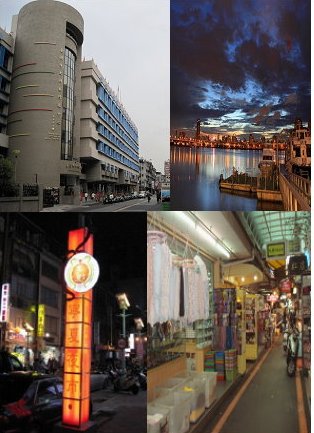
Features
Datong District is located west of Taipei Basin and at the east shore of the Tamsui River. The southern part of the district was previously the site of Dadaocheng, one of the first settlements in Taipei. The northern part was the site of the village of Dalongdong.
The most notable of the district is the traditional Baroque-style architecture on some streets, especially on the Dihua Street. A traditional shopping festival is hosted during the Lunar New Year holidays on the street every year. People purchase dried fruits, nuts, meats, seafood, snacks, Chinese herbs, etc. at shops on the street. When you first walk into the Dihua Street, you will feel like coming to the gallery of Taipei City. Besides, Datong District has several specific commercial zones like the Taipei City Mall and the Railway Rear Station, where visitors can find inexpensive quality leather articles, decoration items, home appliances, etc. The district also boasts well-known night markets like the Ningxia Night Market, the Yansan Night Market, and the Dalong Night Market, selling various kinds of delicious local foods.
Population
130,929(December 31, 2015)
Male: 63,996
Female: 66,933
Area:5.6815 square kilometers
Borough Number 25
History
The district was initially named Ba-lan-bong in the Qing Dynasty and renamed Da-long-dong in 1844 and then renamed Datong in 1946. In 1990, the original Datong District merged the former Jiancheng District, Yanping District and became today's Datong District. The culture of Datong District originated from Dalongdong, close to the crossover section of the Keelung and the Tamsui River.
Datong district was developed earlier than the most of other areas in Taipei City, so there are a lot of historic spots and old temples like the Confucius Temple, the Dalongdong Baoan Temple, Xiahai City God Temple, etc. . In the 19th century, after the Opium War between Britain and the Qing Dynasty, a port was opened officially in Dadaocheng along the Tamsui River for international trade, and many foreign companies were set up here for ex-importing of tea and other merchandises. Business of those foreign trading companies resulted in important influences to the development of the trade and culture of the district.
Tourism
- Taipei Confucius Temple
- Dalongdong Baoan Temple
- Xiahai City God Temple
- Dihua Street & Shopping Festival
- Dadaocheng Wharf (Blue Highway)
- Ningxia Night Market
- Railway Rear Station
- Museum of Contemporary Art, Taipei
District Office Overview

![Taiwan.gov.tw [ open a new window]](/images/egov.png)
